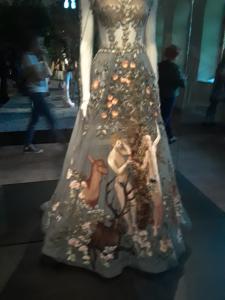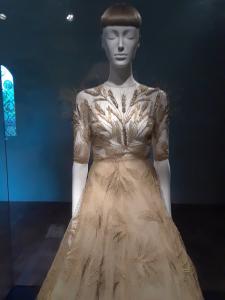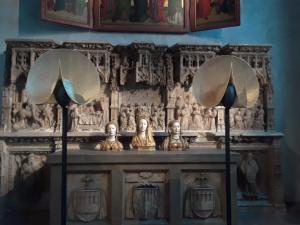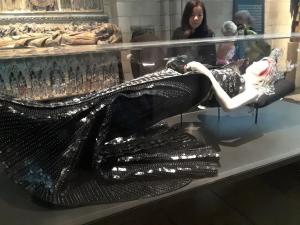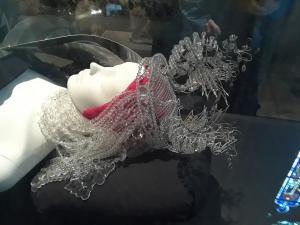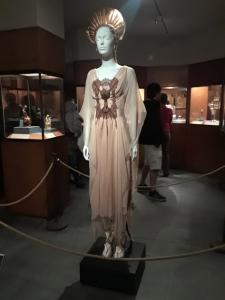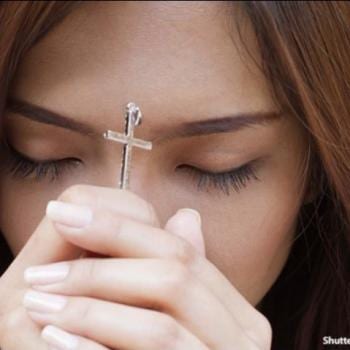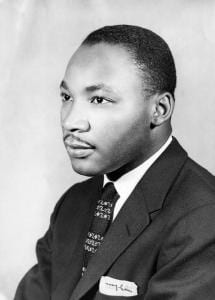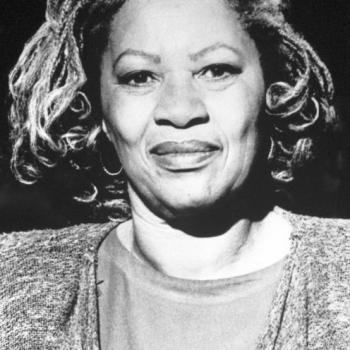In these descriptive essays, guest contributor, Susan L. Miller, captures the incarnational dimension that lies at the heart of both Catholicism and art. It is sometimes difficult for us to see fashion as art. In a sense, fashion is too physical, too concrete. It clothes bodies after all. What’s more, there is an aspect to fashion that is extremely particular. Clothing does not cover some kind of universal and abstract idea of “body.” It covers this *particular* body – the body of a pope, or a celebrity, or a woman. It can shock us to consider fashion an art form, but there is a parallel here to the shocking nature of the Incarnation. Christ was a particular person, and we are assured that he is to be found in the particularity of each person. Grace works mysteriously, and it is part of the work of grace to help us to find God in the particular, whether that’s in a pair of red shoes or a dress worn by Kim Kardashian, or in a person we see every day.
The “Heavenly Bodies” fashion exhibit at both the Met and the Cloisters this year celebrates the “Catholic Imagination,” a term proposed by Andrew Greeley to delineate a Catholic approach to art and life. In Greeley’s formulation, Catholics see the holy in every “creation.”
The “Heavenly Bodies” exhibit demonstrates this over and over. Not only does it convey the labor and thought that go into haute couture, but it also examines the relationship between worship, fashion, and the body – itself a divine creation. The Cloisters are a perfect setting for this, both as a site of religious art and because of the interrelation between the clothing and the art itself. This wing of the exhibition displays some of the most evocative pieces. Here one can see the minimalism of habit-inspired dresses, the extremes of physical suffering and penitence in more structured garments, and the purity of the wedding and evening dresses. Here, more than in any other part of the exhibition, the double-edged Catholic practices of prayer and penitential pain dictate the narrative.
 Two of the most striking dresses are two bridal gowns shown in two chapels of the cloister. In each case, the chapel’s focal point is a crucifix hung high in the cupola. In each chapel, a mannequin wearing a long-trained white dress – half-wedding dress, half-vestment – prays before the image of Christ. This image fits into a chapel beautifully: the figure is worshipper, bride, and confirmand at the same time. The two dresses are unique, however, in their execution. The first, a Balenciaga dress from 1967, skims the
Two of the most striking dresses are two bridal gowns shown in two chapels of the cloister. In each case, the chapel’s focal point is a crucifix hung high in the cupola. In each chapel, a mannequin wearing a long-trained white dress – half-wedding dress, half-vestment – prays before the image of Christ. This image fits into a chapel beautifully: the figure is worshipper, bride, and confirmand at the same time. The two dresses are unique, however, in their execution. The first, a Balenciaga dress from 1967, skims the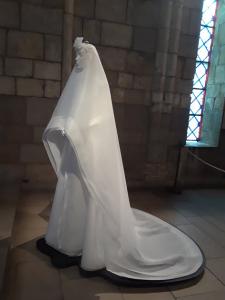 body with simple construction and a train. It is accompanied by a hat whose shape mimics a floating bridal veil. The dress’s construction from two pieces of fabric and three shaping seams make it a classic example of minimal design. By contrast, the second dress – a Dior- veils the head with a white rose at the crown, and a wimple-like cape that extends to the fingertips in front, and to the hem in back. Both wedding dresses resemble the modest dress of nuns or of statues of the Virgin Mary. Both present the bride as mysterious, pure, and devout.
body with simple construction and a train. It is accompanied by a hat whose shape mimics a floating bridal veil. The dress’s construction from two pieces of fabric and three shaping seams make it a classic example of minimal design. By contrast, the second dress – a Dior- veils the head with a white rose at the crown, and a wimple-like cape that extends to the fingertips in front, and to the hem in back. Both wedding dresses resemble the modest dress of nuns or of statues of the Virgin Mary. Both present the bride as mysterious, pure, and devout.
On the lower level of the exhibit are two dresses by Valentino SpA, under Maria Grazia Chiuri and Pierpaolo Piccioli. One has a full skirt embroidered with fine silk threads that create the image of Adam and Eve from Lucas Cranach the Elder’s 1526 painting.
The human characters are flanked by deer on both sides, prefiguring Christ, who is often represented by a stag in religious art. The back of the skirt blooms with irises, flowers associated with the Virgin. The dress makes the theological argument that Adam and Eve’s fall was redeemed by the life of Christ, in a nod to the doctrine of the New Covenant. Its details are painstaking, and frankly gorgeous. We can look at the leaves, the apples, and the tree trunk made entirely of feathers to see this fine work.
The other garment is a full-skirted, floor-length evening dress made of tulle and gold-painted feathers, embroidered to resemble stalks of wheat, a nod to Mary’s role in creating the Bread of Life. The individual barbs of the feathers lift away from the body of the gown, making the dress seem to be made from wheat itself.
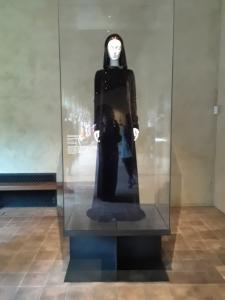 The Cuxa Cloister courtyard and Pontaut Chapter House display habit-inspired clothing for both men and women. Some of the pieces are sublime, others are ridiculous. Because a habit is simple, many of the clothes are timeless, especially some 1960s-70s dresses by Madame Gres and Townley Frocks by Claire McCardell. These dresses show that fashion can be wearable and utilitarian, as well as beautiful. The work of Valentino SpA, under the guidance of Pierpaolo Piccioli, uses the Dominican and Franciscan habits as the basis for sumptuous garments in wool, cashmere, and silk velvet. Their elegance and minimal construction stand in contrast to two Rick Owens pieces. The habits he constructs for men are bulky and flappy, with capelets and folds of fabric that obscure the body’s shape rather than working with it. In addition, they both have peepholes at the crotch, calling to mind the monks that Matthew Lewis created in his scandalous novel The Monk.
The Cuxa Cloister courtyard and Pontaut Chapter House display habit-inspired clothing for both men and women. Some of the pieces are sublime, others are ridiculous. Because a habit is simple, many of the clothes are timeless, especially some 1960s-70s dresses by Madame Gres and Townley Frocks by Claire McCardell. These dresses show that fashion can be wearable and utilitarian, as well as beautiful. The work of Valentino SpA, under the guidance of Pierpaolo Piccioli, uses the Dominican and Franciscan habits as the basis for sumptuous garments in wool, cashmere, and silk velvet. Their elegance and minimal construction stand in contrast to two Rick Owens pieces. The habits he constructs for men are bulky and flappy, with capelets and folds of fabric that obscure the body’s shape rather than working with it. In addition, they both have peepholes at the crotch, calling to mind the monks that Matthew Lewis created in his scandalous novel The Monk.
An appreciation of these clothes requires a sense of humor, 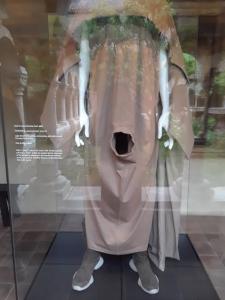 but even if you have one, the experience falls flat. In the Catholic imagination, the penis has been exhibited with dignity, as in dozens of paintings collected in Leo Steinberg’s The Sexuality of Christ in Renaissance Art and Modern Oblivion. In this tradition, Christ’s penis is considered evidence of his full humanity. Compared with a Saint Sebastian or an El Greco Christ, these lumpy pieces seem like bad jokes.
but even if you have one, the experience falls flat. In the Catholic imagination, the penis has been exhibited with dignity, as in dozens of paintings collected in Leo Steinberg’s The Sexuality of Christ in Renaissance Art and Modern Oblivion. In this tradition, Christ’s penis is considered evidence of his full humanity. Compared with a Saint Sebastian or an El Greco Christ, these lumpy pieces seem like bad jokes.
A room with three bust reliquaries of female saints holds three Philip Treacy hats–extreme cornettes of pale gold or white straw. Treacy called them “Madonna Rides Again,” a cheeky evocation of both the divine and the whimsical. One such hat crowned Grace Jones when she sang with Pavarotti in 2002; here, they seem to suggest ornaments for the three saints behind them. On Jones, the hat had seemed a nod to purity that conflicted with her brash sexuality. Here, the hats float on mannequin heads, their wide wings angelic. These are pieces with a sense of humor and a sense of grace.
The Gothic Chapel houses some of the darker pieces in this exhibition, both literally and metaphorically. Between two funerary effigies lies a more contemporary Gothic creation from the House of Dior. John Galliano’s exaggerated hip flanges, black leather pailettes, metallic studs, silver-embroidered corset, and glimmering crown draw from punk as much as royalty. (The crown is made of wire and glass beads, and features dragons, but even more startling is the face of a demon, embroidered in silver thread over the gown’s pubic region.)
Gareth Pugh’s and Olivier Theyskens’ couture constructions in this room are capped with short hairstyles, highlighting their androgyny. They use hooks and eyes or zippers to create cross motifs across their chests, a dramatic contrast to their plain black cloth. Theyskens adds a particularly Catholic edge to his long gown. Its waist, perhaps only 18” in circumference, references the deprivations of female saints whose anorexia was part of their expression of faith. In each of these constructions, a severity with the body – corsetry, hard metal details –exposes the penitence common in Catholic history. Today, and in other contexts, these clothes might have seemed sadomasochistic, but their emphasis on the Cross and on the seduction of sin point to bodily practices of penance that we now associate with fetishists – without the penitential intention.
Mortality also comes to mind in Alexander McQueen’s pieces, showcased upstairs. McQueen used Catholic imagery more than once in his career. In Fall 1998, his “Joan” collection took Joan of Arc as inspiration, culminating in the image of a model whose entire head was covered with chain-mail, standing within a ring of flames. McQueen’s final collection, winter 2010/11, was shown after his death by suicide in February 2010, and four pieces in this room were  part of that final work. One in particular stands out, a full-length gown with a wing-like capelet, printed with an image of the Angel Gabriel from a panel by Hugo van der Goes. This angelic garment is “constructed from a single piece of fabric,” and is a “a tour de force of tailoring,” according to the curatorial notes. The white and grey tones make it funereal, and the image of Gabriel as messenger gives the dress a sense of mystery, even as Gabriel is abstracted into a symmetrical pattern. McQueen seems to have immersed himself in religious art in this last
part of that final work. One in particular stands out, a full-length gown with a wing-like capelet, printed with an image of the Angel Gabriel from a panel by Hugo van der Goes. This angelic garment is “constructed from a single piece of fabric,” and is a “a tour de force of tailoring,” according to the curatorial notes. The white and grey tones make it funereal, and the image of Gabriel as messenger gives the dress a sense of mystery, even as Gabriel is abstracted into a symmetrical pattern. McQueen seems to have immersed himself in religious art in this last 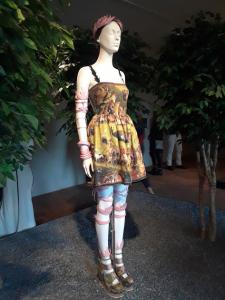 phase of his life, as all these pieces use paintings for their pattern. One short dress is decorated with images from Hieronymous Bosch’s “Temptation of St. Anthony,” one of the most terrifying paintings in Western art. (There is a suite of lovely Bosch-inspired Jun Takahashi dresses downstairs, but their images are all taken from the first two panels of “The Garden of Earthly Delights,” a painting with more whimsical imagery.) Considering the torment McQueen experienced during this year, the beauty of his garments and their relative severity seem appropriate. Downstairs, a sterling silver crown of thorns by McQueen and Shaun Leane both sparkles and pricks. Even early on, McQueen’s religious work created painful, startling images.
phase of his life, as all these pieces use paintings for their pattern. One short dress is decorated with images from Hieronymous Bosch’s “Temptation of St. Anthony,” one of the most terrifying paintings in Western art. (There is a suite of lovely Bosch-inspired Jun Takahashi dresses downstairs, but their images are all taken from the first two panels of “The Garden of Earthly Delights,” a painting with more whimsical imagery.) Considering the torment McQueen experienced during this year, the beauty of his garments and their relative severity seem appropriate. Downstairs, a sterling silver crown of thorns by McQueen and Shaun Leane both sparkles and pricks. Even early on, McQueen’s religious work created painful, startling images.
 Some of the most striking works are the extraordinary Jean-Paul Gaultier dresses. A “Guadalupe” gown inspired by the Sacred Heart of Mary displays an embroidered heart of red silk, red beads, and silver sword on its breast, with an inset of red silk mousseline descending the skirt, spreading from the hip to the floor-length hem. The heart drips with ruby-colored beads that mimic drops of blood. The blue silk jersey of
Some of the most striking works are the extraordinary Jean-Paul Gaultier dresses. A “Guadalupe” gown inspired by the Sacred Heart of Mary displays an embroidered heart of red silk, red beads, and silver sword on its breast, with an inset of red silk mousseline descending the skirt, spreading from the hip to the floor-length hem. The heart drips with ruby-colored beads that mimic drops of blood. The blue silk jersey of 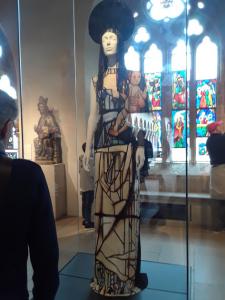 the rest of the dress is draped rather than tailored, like the folds of Mary’s veil. The red silk section exposes the shape of the wearer’s leg beneath, expressing a discreet sexuality. The molding of the jersey to the body leaves no mystery about the woman’s form, but it skims rather than stretches, giving an impression of lightness. In the same room, a silk chiffon dress printed with a stained-glass image of Mary’s body fools the eye – the wearer appears to be holding the infant Christ, who is printed on the bodice and the single long sleeve. Located in front of a stained-glass window from the collection, it seems a natural extension of Catholic art.
the rest of the dress is draped rather than tailored, like the folds of Mary’s veil. The red silk section exposes the shape of the wearer’s leg beneath, expressing a discreet sexuality. The molding of the jersey to the body leaves no mystery about the woman’s form, but it skims rather than stretches, giving an impression of lightness. In the same room, a silk chiffon dress printed with a stained-glass image of Mary’s body fools the eye – the wearer appears to be holding the infant Christ, who is printed on the bodice and the single long sleeve. Located in front of a stained-glass window from the collection, it seems a natural extension of Catholic art.
However, my favorite dress is displayed between sterling chalices and a joyful ivory Virgin and Child. This Gaultier dress of pale pink silk mousseline has an appliqued chalice of brown lace on its bodice, the color of dried blood. Around the chalice, the lace forms a frame that crosses over the cleavage, down the breasts, and across the abdomen, trailing down into the folds of the skirt.
The garment’s handkerchief hem and loose sleeves make the entire garment seem airy and light, even as it evokes an altar cloth. Even though the curatorial note describes the “cupping” of the breasts as “a provocation,” this gown honors the Virgin’s role in our salvation. Her body as a vessel for the blood of Christ becomes an integral part of the story here, and the dress is a piece of religious art as inspiring to me as any icon.
Susan L. Miller is the author of Communion of Saints: Poems, and has poems in the anthologies Collective Brightness: LGBTIQ Poets on Faith, Religion, and Spirituality and St. Peter’s B-List: Contemporary Poems Inspired by the Saints. She teaches creative writing at Rutgers University and lives in Brooklyn, NY, with her family.
Photographs are her own.

